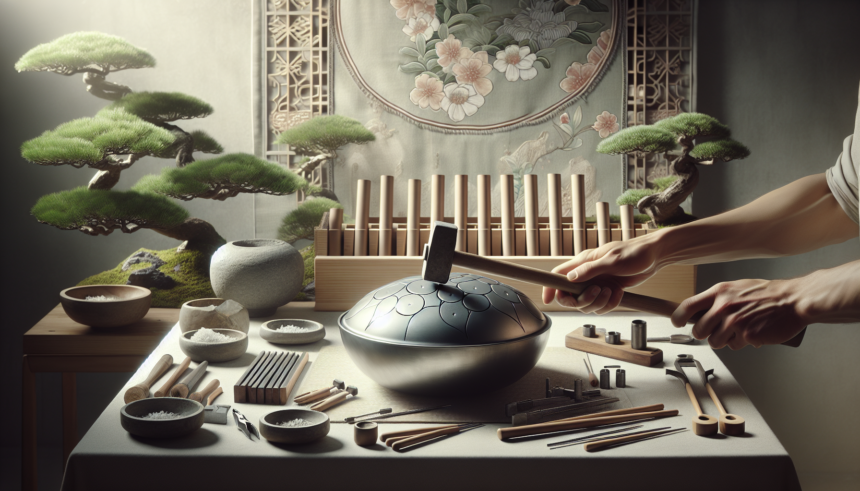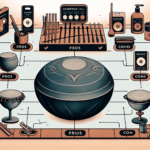The Art of Handpan Craftsmanship
The handpan, a mesmerizing instrument known for its ethereal sound, has captured the hearts and minds of musicians and listeners around the world. These instruments, often referred to as “steel pans” or “hang drums,” are not just musical tools but works of art that carry within them a sense of serenity and mindfulness. The journey of creating a Zen Percussion handpan is one that requires exceptional skill, patience, and an unwavering dedication to craftsmanship.
History and Origin
Handpans have an intriguing history that traces back to the early 2000s. The instrument’s predecessors can be found in the steelpan family, which originated in Trinidad and Tobago. The modern handpan, however, was developed and popularized by Felix Rohner and Sabina Schärer of PANArt in Switzerland. Their creation drew inspiration from various cultures and musical traditions, resulting in an instrument that is as visually captivating as it is sonically enchanting.
Crafting Process
The creation of a Zen Percussion handpan is a meticulous process that demands a combination of scientific precision and artistic intuition. Each instrument is carefully handcrafted from high-quality steel. The process involves several key stages:
1. Shaping the Metal
The first step in crafting a handpan involves shaping the metal. High-grade steel sheets are carefully selected and cut into circular blanks. These blanks are then meticulously hammered and shaped into a dome-like structure. This shaping process is critical as it determines the overall tone and resonance of the instrument.
2. Heat Treatment
Once the initial shape has been achieved, the handpan undergoes a heat treatment process. This involves heating the metal to a specific temperature and then allowing it to cool gradually. Heat treatment helps to stabilize the metal and enhance its tonal qualities.
3. Creating the Notes
The distinctive feature of a handpan is its collection of carefully tuned notes. These notes are created by embossing and carving precision-shaped indentations on the surface of the instrument. Each note is meticulously tuned to ensure perfect harmony and resonance. This tuning process is often referred to as “hammering” and is performed by skilled artisans who possess a deep understanding of acoustics and musical theory.
4. Fine-Tuning
After the initial tuning, the handpan undergoes a series of fine-tuning sessions. This involves refining the shape and depth of each note to achieve the desired pitch and timbre. The tuning process is iterative and requires a keen ear and a delicate touch. The goal is to create an instrument that produces a balanced and harmonious sound across all its notes.
5. Surface Treatment
Once the tuning is complete, the handpan’s surface is treated to enhance its durability and appearance. This may involve processes such as nitriding, which strengthens the metal and provides corrosion resistance. The surface is also often treated with coatings that can enhance the instrument’s aesthetic appeal.
The Spirit of Zen
What sets Zen Percussion handpans apart is not just their exceptional craftsmanship but also the philosophy and spirit that goes into their creation. The name “Zen” is chosen deliberately, as it embodies a sense of mindfulness and tranquility. The artisans at Zen Percussion believe that the process of crafting a handpan is not just a mechanical task but a deeply meditative and spiritual practice. Each instrument is imbued with a sense of calm and serenity, making it a conduit for mindfulness and inner peace.
Playing the Handpan
Playing a handpan is an experience that transcends ordinary musical expression. The instrument’s intuitive layout and soothing tones make it accessible to players of all skill levels. Whether you are an experienced musician or a novice, the handpan invites you to explore its melodic landscapes and create music that resonates with your soul.
The Global Handpan Community
The popularity of handpans has given rise to a vibrant global community of musicians, makers, and enthusiasts. Handpan festivals, workshops, and gatherings are held around the world, bringing together people who share a passion for this unique instrument. This sense of community fosters collaboration, learning, and the continued evolution of handpan craftsmanship.
Conclusion
In the world of musical instruments, the handpan stands out as a testament to the artistry and dedication of its creators. Zen Percussion handpans, in particular, exemplify the fusion of craftsmanship, mindfulness, and musicality. Each instrument is a work of art that carries within it the spirit of serenity and the promise of harmonious melodies. As you play a Zen Percussion handpan, you become part of a tradition that celebrates not just music but the profound connection between the human spirit and the art of sound.
FAQs
1. What is the difference between a handpan and a steelpan?
While both instruments share similarities in their metallic construction, a handpan is typically played with the hands and has a more ethereal and resonant sound due to its unique shape and tuning. A steelpan, on the other hand, is played with mallets and originates from Trinidad and Tobago.
2. How long does it take to create a Zen Percussion handpan?
The crafting process for a Zen Percussion handpan can take several weeks to complete. This includes shaping the metal, heat treatment, tuning, fine-tuning, and surface treatment. The exact duration depends on the complexity of the instrument and the desired tonal qualities.
3. Can anyone learn to play the handpan?
Yes, the handpan is known for its intuitive layout and ease of play. While it may take time to master, anyone with a passion for music can learn to play the handpan. Many beginners find it accessible and enjoyable from the start.
4. What materials are used in the construction of a handpan?
Handpans are typically made from high-quality steel. Some handpans undergo additional surface treatments, such as nitriding, to enhance their durability and tonal qualities. The specific materials and treatments used can vary between different handpan makers.
5. How should I care for my handpan?
To ensure the longevity and optimal performance of your handpan, it is important to store it in a protective case when not in use, avoid exposure to extreme temperatures and humidity, and clean it regularly with a soft cloth. Additionally, periodic maintenance and professional tuning may be necessary to keep the instrument in top condition.





